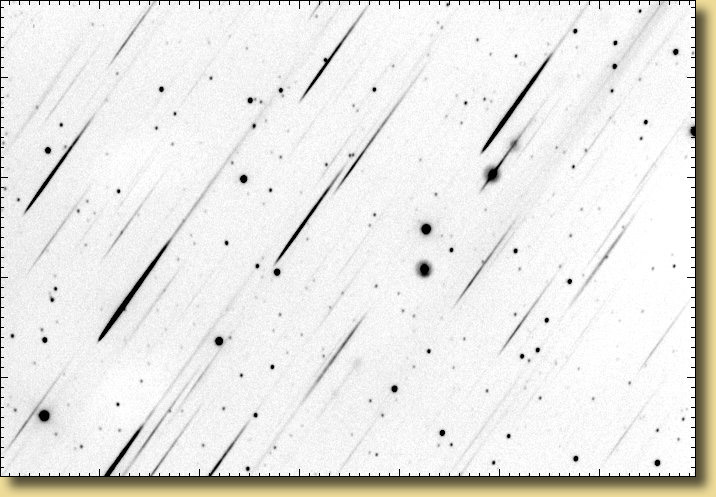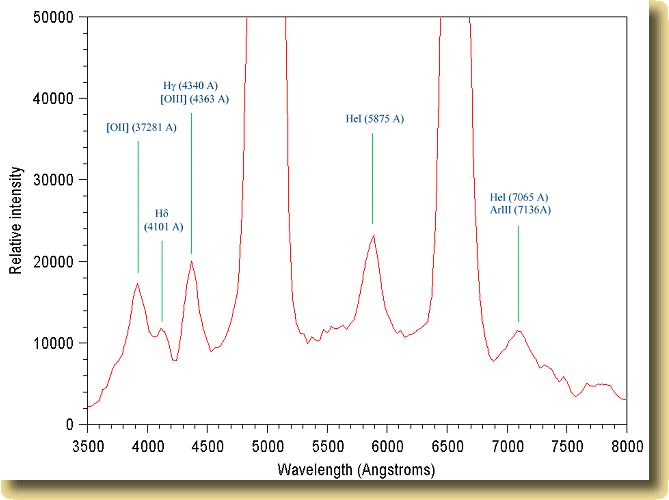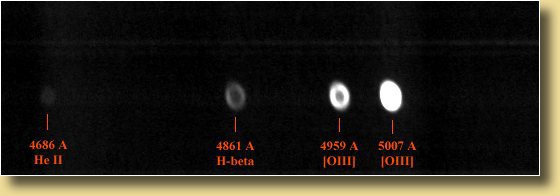
 A spectrograph without slit is essentially a spectro-imagor, i.e. an instrument
able to acquire the spectrum of several objects simultaneously. When an
object has a structure, it is the case with a planetary nebula, it makes
it possible to analyze its morphology according to the wavelength.
A spectrograph without slit is essentially a spectro-imagor, i.e. an instrument
able to acquire the spectrum of several objects simultaneously. When an
object has a structure, it is the case with a planetary nebula, it makes
it possible to analyze its morphology according to the wavelength.
 The image shows the field of planetary
nebula NGC 2392 (the Clown nebula) captured with a Jeulin grating (100
lines/mm) placed 21 mm in front ot the surface of KAF-0400 CCD equipping
the Audine camera. The telescope is a flat-field camera of 190 mm at F/D=4.
The final image represents a combining of ten 2 minutes exposures. The
zero order of this one is just on the right center of the image (one may
guess the nebular glow). Notice that each star has a spectrum associated.
The nebula spectrum is complex: one sees at the same time the spectrum
of the central star which is of magnitude 9 approximately and several monochromatic
images of the nebula which are superimposed on it. The Jeulin grating concentrates
approximately 50% of the signal in the order #0, 40% in the order #1 and
10% in the other orders.
The image shows the field of planetary
nebula NGC 2392 (the Clown nebula) captured with a Jeulin grating (100
lines/mm) placed 21 mm in front ot the surface of KAF-0400 CCD equipping
the Audine camera. The telescope is a flat-field camera of 190 mm at F/D=4.
The final image represents a combining of ten 2 minutes exposures. The
zero order of this one is just on the right center of the image (one may
guess the nebular glow). Notice that each star has a spectrum associated.
The nebula spectrum is complex: one sees at the same time the spectrum
of the central star which is of magnitude 9 approximately and several monochromatic
images of the nebula which are superimposed on it. The Jeulin grating concentrates
approximately 50% of the signal in the order #0, 40% in the order #1 and
10% in the other orders.
The following figure presents the spectral profile of NGC 2392 extracted
from the preceding image. The lines [ OIII ] at 5007 A and Ha
at 6563 A are particularly intense. The spectrum shows in fact monochromatic
images of the nebula (the "continuum" spectra of its central star is also
visible). The hole in the lines is explained well if one remembers that
nebula is a ring and that spectral profile pass roughly by its center.
 Spectral profile of nebula NGC 2392.
Spectral profile of nebula NGC 2392.
 The spectrum of planetary nebula M57 taken
with a prism spectrograph. Chromatism of the photographic objectives used
in the spectrograph is very severe. It results in a strong widening (defocus)
in the infra-red part of the spectrum. The image of comparison, on the
left, captured in polychromatic light (extracted from the BT-Atlas).
The spectrum of planetary nebula M57 taken
with a prism spectrograph. Chromatism of the photographic objectives used
in the spectrograph is very severe. It results in a strong widening (defocus)
in the infra-red part of the spectrum. The image of comparison, on the
left, captured in polychromatic light (extracted from the BT-Atlas).
 The spectrum of the nebula NGC6826 captured
under the same conditions as for the preceding image. The spectrum of central
star is quite visible here.
The spectrum of the nebula NGC6826 captured
under the same conditions as for the preceding image. The spectrum of central
star is quite visible here.
 The nebula NGC 6210 observed with the
190-mm telescope and a grating Rainbow Optics of 200 lines/mm (April, 24,
1999). We favorise here luminosity rather than the spectral resolution.
Thus, the grating is placed very close to the CCD: 13.4 mm in front of
it. This was possible with Audine camera by placing the grating even inside
the box of the camera. Dispersion is 32 A/mm approximately.
The nebula NGC 6210 observed with the
190-mm telescope and a grating Rainbow Optics of 200 lines/mm (April, 24,
1999). We favorise here luminosity rather than the spectral resolution.
Thus, the grating is placed very close to the CCD: 13.4 mm in front of
it. This was possible with Audine camera by placing the grating even inside
the box of the camera. Dispersion is 32 A/mm approximately.
 Spectral profile of NGC 6210 captured
with the grating Rainbow Optics.
Spectral profile of NGC 6210 captured
with the grating Rainbow Optics.
 Detail on the weak emission lines of NGC
6210. The use of CCC KAF-0401E, by its great sensitivity in blue, made
possible the detection of the line [OII] at 3738 A.
Detail on the weak emission lines of NGC
6210. The use of CCC KAF-0401E, by its great sensitivity in blue, made
possible the detection of the line [OII] at 3738 A.
 The spectrum of nebula M57 in the vicinity
of line Hacaptured Aug'99 with a spectrograph
at the resolution of 3000 approximately. Sampling is of 0.93
A/pixel. Co-adding of 17 images, 120 seconds exposures each. This document
shows that line Ha is not the only source of
light in this area of the planetary nebula spectra. This one is surrounded
by the lines [ NII ], which still are more intense. The line at 6364 A
is [OI]. For a peculiar processing of this image, click
here.
The spectrum of nebula M57 in the vicinity
of line Hacaptured Aug'99 with a spectrograph
at the resolution of 3000 approximately. Sampling is of 0.93
A/pixel. Co-adding of 17 images, 120 seconds exposures each. This document
shows that line Ha is not the only source of
light in this area of the planetary nebula spectra. This one is surrounded
by the lines [ NII ], which still are more intense. The line at 6364 A
is [OI]. For a peculiar processing of this image, click
here.

 Spectrum of M57 in the green region. Note
the small size of the nebula in the 4686 A He II line (only the central
part emit at this wavelength).
Spectrum of M57 in the green region. Note
the small size of the nebula in the 4686 A He II line (only the central
part emit at this wavelength).












